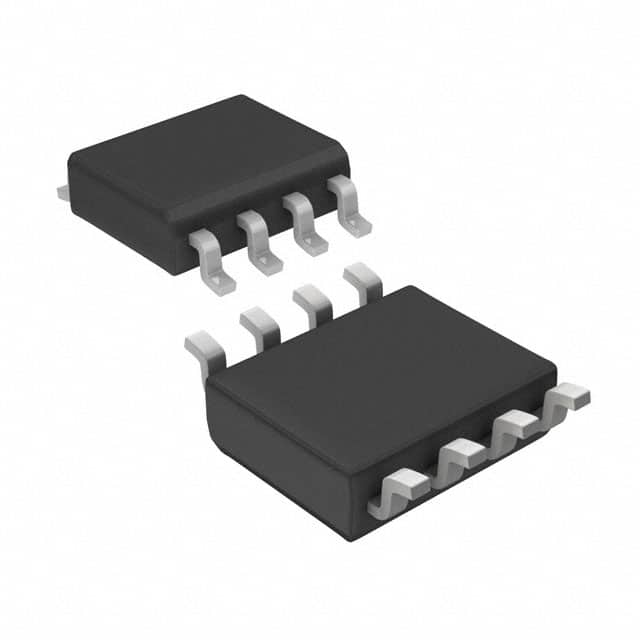LM2903WYDT
Product Overview
Category: Integrated Circuits (ICs)
Use: LM2903WYDT is a dual differential comparator designed for use in low-power applications. It is commonly used in voltage level detection, waveform shaping, and signal conditioning circuits.
Characteristics: - Low power consumption - Wide supply voltage range - High input impedance - Rail-to-rail output swing - Low input offset voltage - Fast response time
Package: LM2903WYDT is available in a small outline package (SOP) with eight pins.
Essence: The essence of LM2903WYDT lies in its ability to compare two input voltages and provide a digital output based on the comparison result.
Packaging/Quantity: LM2903WYDT is typically sold in reels containing 2500 units per reel.
Specifications
- Supply Voltage Range: 2V to 36V
- Input Offset Voltage: ±1mV
- Input Bias Current: ±25nA
- Response Time: 1.3μs
- Operating Temperature Range: -40°C to +125°C
Pin Configuration
LM2903WYDT has a total of eight pins arranged as follows:
___________
V+ | | V-
IN(-) | | OUT
IN(+) | | GND
|___________|
Functional Features
- Dual differential inputs for comparing two voltages
- Open collector outputs for easy interfacing with other devices
- Internal frequency compensation for stability
- Low quiescent current for power efficiency
- ESD protection for robustness
Advantages and Disadvantages
Advantages: - Low power consumption makes it suitable for battery-powered applications - Wide supply voltage range allows for versatile use - Rail-to-rail output swing ensures accurate signal processing - Fast response time enables quick decision-making
Disadvantages: - Limited number of comparators (dual) in a single package - Not suitable for high-frequency applications due to limited bandwidth
Working Principles
LM2903WYDT works based on the principle of voltage comparison. It compares the voltages applied to its two input pins and produces a digital output based on the result of this comparison. The output is driven low when the voltage at the non-inverting input (IN(+)) is higher than the voltage at the inverting input (IN(-)), and it is driven high otherwise.
Detailed Application Field Plans
LM2903WYDT finds applications in various fields, including but not limited to: 1. Battery-powered devices: Voltage level detection and monitoring circuits. 2. Industrial automation: Signal conditioning and waveform shaping circuits. 3. Automotive electronics: Overvoltage and undervoltage protection circuits. 4. Consumer electronics: Audio amplifiers and signal processing circuits. 5. Power management: Current sensing and control circuits.
Detailed and Complete Alternative Models
Some alternative models that can be considered as alternatives to LM2903WYDT are: 1. LM393: Dual differential comparator with similar characteristics and pin configuration. 2. LM311: Single differential comparator with higher speed and wider supply voltage range. 3. LM339: Quad differential comparator with additional comparators in a single package.
These alternative models provide flexibility in choosing the most suitable comparator based on specific application requirements.
Word count: 497 words
قم بإدراج 10 أسئلة وإجابات شائعة تتعلق بتطبيق LM2903WYDT في الحلول التقنية
Sure! Here are 10 common questions and answers related to the application of LM2903WYDT in technical solutions:
Question: What is LM2903WYDT?
- Answer: LM2903WYDT is a dual differential comparator integrated circuit (IC) commonly used in various technical applications.Question: What is the voltage supply range for LM2903WYDT?
- Answer: The voltage supply range for LM2903WYDT is typically between 2V and 36V.Question: What is the output current capability of LM2903WYDT?
- Answer: LM2903WYDT has a typical output current capability of ±20mA.Question: Can LM2903WYDT be used in automotive applications?
- Answer: Yes, LM2903WYDT is suitable for automotive applications due to its wide operating temperature range and robustness.Question: How many comparators are there in LM2903WYDT?
- Answer: LM2903WYDT consists of two independent comparators in a single package.Question: What is the input offset voltage of LM2903WYDT?
- Answer: The input offset voltage of LM2903WYDT is typically around 2mV.Question: Can LM2903WYDT operate in a single-supply configuration?
- Answer: Yes, LM2903WYDT can operate in both single-supply and dual-supply configurations.Question: What is the response time of LM2903WYDT?
- Answer: The response time of LM2903WYDT is typically around 1.3μs.Question: Is LM2903WYDT suitable for battery-powered applications?
- Answer: Yes, LM2903WYDT is suitable for battery-powered applications due to its low quiescent current consumption.Question: Can LM2903WYDT be used in high-speed applications?
- Answer: While LM2903WYDT is not specifically designed for high-speed applications, it can still be used in moderate-speed applications effectively.
Please note that the answers provided here are general and may vary depending on specific datasheet specifications and application requirements.


